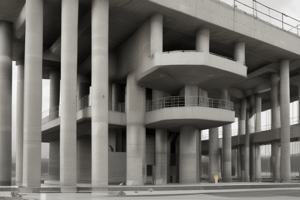Podcast
Questions and Answers
Which material acts as the primary binding agent in Portland cement concrete (PCC)?
Which material acts as the primary binding agent in Portland cement concrete (PCC)?
- Aggregate
- Admixtures
- Cement (correct)
- Water
What is a key characteristic of self-consolidating concrete (SCC)?
What is a key characteristic of self-consolidating concrete (SCC)?
- Is designed for high compressive strength
- Has a low water-cement ratio
- Requires intense vibration to fill forms
- Flows and fills forms without vibration (correct)
Which factor primarily impacts the compressive strength of concrete over time?
Which factor primarily impacts the compressive strength of concrete over time?
- Curing conditions and age (correct)
- Amount of admixture added
- Temperature variations during mixing
- Type of aggregate used
Why is controlling the water content in concrete important?
Why is controlling the water content in concrete important?
What is a defining feature of high-performance concrete (HPC)?
What is a defining feature of high-performance concrete (HPC)?
Which type of concrete is specifically designed for rapid construction due to its quick strength gain?
Which type of concrete is specifically designed for rapid construction due to its quick strength gain?
What describes the property of durability in concrete?
What describes the property of durability in concrete?
Which strength is normally lower in concrete compared to its other strengths?
Which strength is normally lower in concrete compared to its other strengths?
What is creep in the context of concrete technology?
What is creep in the context of concrete technology?
Which of the following factors is least likely to affect concrete quality?
Which of the following factors is least likely to affect concrete quality?
Why is curing a critical phase in concrete production?
Why is curing a critical phase in concrete production?
What is the primary goal of batching in concrete production?
What is the primary goal of batching in concrete production?
Which concrete application is focused on creating a surface capable of supporting traffic?
Which concrete application is focused on creating a surface capable of supporting traffic?
How does shrinkage in concrete primarily occur?
How does shrinkage in concrete primarily occur?
What must be considered when transporting concrete to ensure quality?
What must be considered when transporting concrete to ensure quality?
Which factor is not directly related to mixing and placing procedures?
Which factor is not directly related to mixing and placing procedures?
Flashcards
Concrete
Concrete
A composite material made of cement, aggregate, and water.
Portland Cement Concrete (PCC)
Portland Cement Concrete (PCC)
The most common type of concrete, using Portland cement as the binder.
High-performance Concrete (HPC)
High-performance Concrete (HPC)
Concrete designed for higher strength and durability in specific applications.
Self-consolidating Concrete (SCC)
Self-consolidating Concrete (SCC)
Signup and view all the flashcards
Compressive Strength
Compressive Strength
Signup and view all the flashcards
Durability
Durability
Signup and view all the flashcards
Workability
Workability
Signup and view all the flashcards
Water in Concrete
Water in Concrete
Signup and view all the flashcards
Creep
Creep
Signup and view all the flashcards
Shrinkage
Shrinkage
Signup and view all the flashcards
Batching
Batching
Signup and view all the flashcards
Mixing
Mixing
Signup and view all the flashcards
Transport
Transport
Signup and view all the flashcards
Placement
Placement
Signup and view all the flashcards
Curing
Curing
Signup and view all the flashcards
Factors Affecting Concrete Quality
Factors Affecting Concrete Quality
Signup and view all the flashcards
Study Notes
Introduction to Concrete Technology
- Concrete is a composite material primarily composed of cement, aggregate (sand and gravel), and water.
- It's a versatile and widely used construction material, valued for its compressive strength, durability, and cost-effectiveness.
- Concrete's properties can be tailored through variations in composition and curing processes.
Types of Concrete
- Portland cement concrete (PCC) is the most common type, using Portland cement as the binding agent.
- Other types include:
- High-performance concrete (HPC): Designed for specific applications demanding higher strength, durability, or specific properties.
- Self-consolidating concrete (SCC): Designed to flow and fill forms without vibration, essential for complex shapes.
- High-early-strength concrete: Intended for rapid construction, gaining strength quickly after placement.
- Light-weight concrete: Lower density, reducing load on structures or used where weight is a concern.
Concrete Composition
- Cement: The binder that hydrates when mixed with water, forming a paste that binds aggregate particles. Portland cement is a key ingredient, driving the majority of concrete's strength gain over time.
- Aggregate: Inert materials like sand and gravel, contributing to volume and providing strength. Different aggregate sizes impact workability and strength.
- Water: Essential for cement hydration, impacting workability and strength. Water content must be meticulously controlled.
Concrete Properties
- Compressive Strength: Resistance to crushing; critical for structural integrity. Strength increases with age and proper curing.
- Tensile Strength: Ability to withstand pulling forces; generally lower than compressive strength.
- Durability: Resistance to weathering, chemical damage, and abrasion. Durability is profoundly affected by exposure conditions, environmental factors, and material quality.
- Workability: Ease of placement and compaction into forms. Workability is affected by the concrete mixture proportion, including water-cement ratio.
- Creep: Gradual deformation under sustained load. Concrete creep must be considered in design calculations.
- Shrinkage: Changes in volume due to hydration and drying. Shrinkage can cause cracking and must be accounted for in construction.
Concrete Production
- Batching: Precise measurement of cement, aggregate, and water for consistent quality.
- Mixing: Combining ingredients for a homogeneous concrete mix. Mixing methods affect mix uniformity and final properties.
- Transport: Moving concrete to the placement site; time limits and methods impact quality.
- Placement: Pouring concrete into forms to create shapes. Placement techniques are vital for quality.
- Curing: Maintaining appropriate moisture levels to allow cement hydration, maximizing strength, durability, and safety. Curing is a key phase for controlling quality.
Concrete Applications
- Foundation construction
- Road pavements
- Bridge decks
- Building structures
- Dam construction
- Architectural elements
- Precast elements
- Repairing damaged or degraded concrete structures
Factors Affecting Concrete Quality
- Cement type and quality
- Aggregate type and quality
- Water-cement ratio
- Mixing and placing procedures
- Curing conditions
- Ambient temperature during curing
- External factors like environmental conditions
Conclusion
- Concrete technology involves a wide range of concepts and procedures. Understanding these elements is crucial for professionals in construction and related industries. The principles ensure the quality and longevity of structures.
Studying That Suits You
Use AI to generate personalized quizzes and flashcards to suit your learning preferences.




